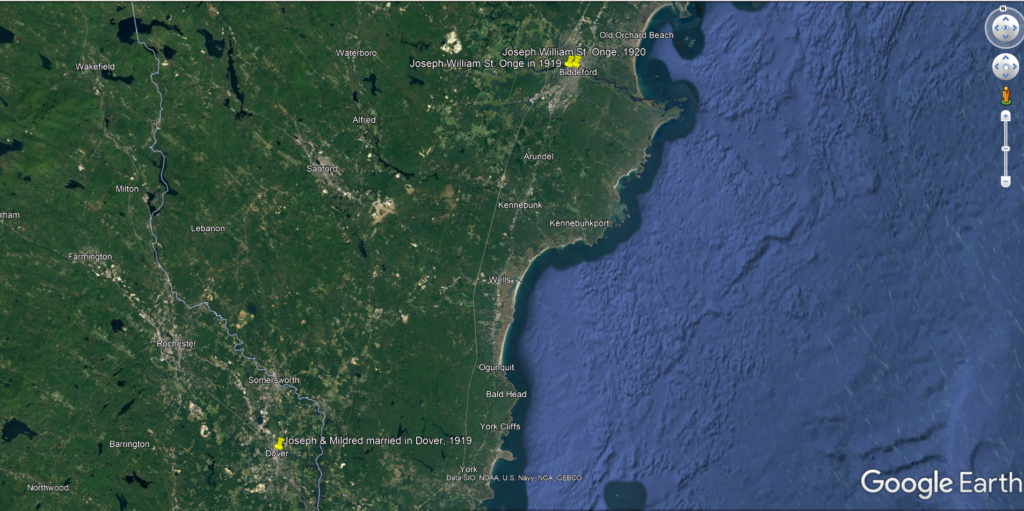I’ve spent so much time writing about my paternal side of the family for 52 Ancestors that this week offers the perfect topic to shift the focus to my maternal side. When DNA testing first emerged as commercially-available, I got an mtDNA test from Family Tree DNA. The autosomal testing was less of a thing, so I thought this was the best place for me to start my DNA foray. Over time, I upgraded to full sequence to refine the results, while also testing or uploading my autosomal DNA with every company available. Learning more about my mtDNA matches and trying to make a family connection has been an ongoing project and challenge.
My mtDNA haplogroup is H1aJ1, and of the full sequence matches I have, two are at a genetic distance of 0, seventeen are at a genetic distance of 2, and five are at a genetic distance of 3. Most of these matches have ancestors from western Europe and have Jewish surnames. Of my two closest matches, one is my maternal uncle and the other is an Italian man whose maternal ancestors are from Gratteri, Palermo, Sicily. I have been able to take his maternal tree back to approximately 1740 at this time. He is the person with whom I am trying to find a common ancestor, by researching both of our maternal lines. Will mine ever connect with his? Well…
My Mother & My Nanas
My mother is 66-years-old as I write this. While I didn’t grow up with her, we communicate fairly regularly now. She shares my interest in genealogy, among many other things. I tend to tell her about all the interesting things I find.
Her mother, my Nana, is also still living. She will turn 92-years-old next week. Most of Nana’s siblings have passed away, including all of her sisters, the last one only a few weeks ago. Nana is one of 8 siblings – four boys, four girls – and I was able to spend many wonderful days with her during my childhood, and even more when I became an adult.
Her mother, Nana Bartlett, passed away in 1991 at the age of 88, and I have some memories of her. Nana Bartlett was always short, white-haired, and very sweet. She was also one of 8 children, also four boys and four girls. The firstborns, twin boys, died as infants in Italy. Except for the third brother, who emigrated to the U.S. with their mother, the remaining five siblings were all born in the United States. Nana Bartlett used to admire my drawings, even though I wouldn’t have considered myself at all talented.
Ernesta Maddalena Pedemonte Bergamasco
My most confusing maternal ancestor was great-great grandma Ernesta. That’s because you can find her under 3 different surnames, depending on what records you’re looking at. Thank goodness I was able to sort them out, from birth to death!
Ernesta was born 14 May 1873 in Moneglia, Genoa, Liguria, Italy. Her birth record is under the name Maddalena Pedemonte, and her father is not named. She had 6 full siblings and 3 older half-siblings, all through her mother. When Ernesta married my great-great grandfather, Bartolomeo Giovanni Michele Galfré, her birth was basically legitimized by her mother marrying the man who we believe to be the father of the 6 full siblings, Giuseppe Bergamasco. However, Ernesta’s name at the time of her marriage on 24 October 1896 in Sanremo, Imperia, Liguria, Italy is listed as Maddalena Pedemonte.
She emigrated to the United States sometime in or about 1899, though we don’t have an exact date, or port of departure or entry. All we know is the family story that she and her son, Dante Michele Giuseppe Galfre, arrived “on a cow boat.” In U.S. records, she starts showing up as Ernesta Bergamasco when named on her children’s marriages, and that is also given as her maiden name at the time of her death. Ernesta is pictured here in front of the family’s home in Middleborough, Plymouth, Massachusetts. She passed away on 8 March 1925, only 51 years old, and remembered by her daughters as “a saint on earth.”

Catarina Santina Pedemonte
Catarina is my 3rd-great grandmother, and we don’t know much about her. She was born on 15 December 1842 in Cogoleto, Genova, Liguria, Italy. By about 1864, she was married to Giacomo Spiazzi, the son of Bartolomeo Spiazzi. He was from Verona and, after having three children with Catarina, went to South America. Why he left Italy, we don’t know. Maybe it was for business or maybe it was to emigrate.
We will probably never know, because he died of cholera in Buenos Aires, Argentina in February of 1869, leaving Catarina with three young children – Bartolomeo, born 13 June 1865 in Finale Pia, Savona, Liguria, Italy; Emilia Spiazzi, born about 1866; and Angela Spiazzi, born 23 June 1868 in Cogoleto. Giuseppe Bergamasco was the godfather of the eldest child and, it seems, the father of Catarina’s next six children.
Between 1870 and 1886, Catarina and Guiseppe had six children. However, only one of the parents is named in each birth record, sometimes the mother and sometimes the father. The children – Giovanni, Maddalena, Theresa, Enrico, Pietro, Alessandro, Battista, and Adele – all appear with different last names because of this. Giuseppe was only five years older than Catarina, so there wasn’t a significant age difference or anything like that.
I really wish I knew Catarina’s story, how she ended up married first to a butcher from Verona and then to a simple miner from Cairo Montenotte. I also wish I knew why it took so long for her and Giuseppe to finally get married on 25 October 1894 in Moneglia. Catarina died on 16 December 1909 in Moneglia, while Giuseppe lived on until at least 1941. By family accounts, he lived to be 104 years old, went to church one night, said goodbye to his friends, and then had passed away by morning. That story interests me, of course, but not as much as Catarina’s!
Angela Giusto & Maria Bruzzone
Here, we get even fuzzier on maternal knowledge, because I can’t find records earlier than Catarina’s baptism. However, I know her parents were Tomaso Pedemonte and Angela Giusto, both of which are common surnames in Cogoleto. Perhaps Angela was born about 1814, but that’s an estimate based on the births of her two known children – Catarina and Giovanni. Giovanni may have been born about 1830, based upon his age at the time of his marriage in 1867, the births of his children, and his death in 1887. I’m sure there must also be other siblings in that 12-year gap between Giovanni and Catarina.
Angela must have passed away between 1842, when Catarina was born, and 1865, because available Cogoleto vital records begin in 1866 and I can’t find a death for her there. Both she and Tomaso Pedemonte passed away before Catarina’s marriage in 1894, because her parents are listed as “fu” (deceased). I have Tomaso’s death record from 1893 but, again, nothing on Angela. Where Catarina appears to have lived quite a topsy-turvy life, I think Angela’s was probably tame by comparison. She married, had children, and passed away rather young.
Her father was Giovanni Giusto and her mother may have been Maria Bruzzone. Unfortunately, this is where the trail goes cold. I can estimate that both Giovanni and Maria were born about 1780 and died before 1866. They had certainly passed away before 1872, because another daughter, Lorenzina, died in 1872 and her death record specified that her parents were deceased. Naturally, I would like to be certain about Angela’s mother as I strive to bridge the gap between my maternal ancestors in Northern Italy and my closest mtDNA match’s ancestors in Sicily.
These are two totally different worlds within one country, as you may know. So I wonder if my ancestors came north from Sicily, or if my DNA match’s went south from Liguria. It’s also likely that I have to work further back, to Portugal or somewhere else on the Iberian Peninsula, to find that shared ancestor. And, of course, we may not be able to identify any common ancestor in a genealogically relevant time frame, simply because of the slowly-mutating nature of mtDNA.
Regardless, I’m enjoying the hunt. I just wish my female ancestors in Italy had found a way to tell their stories, because I’m endlessly fascinated with them.



















